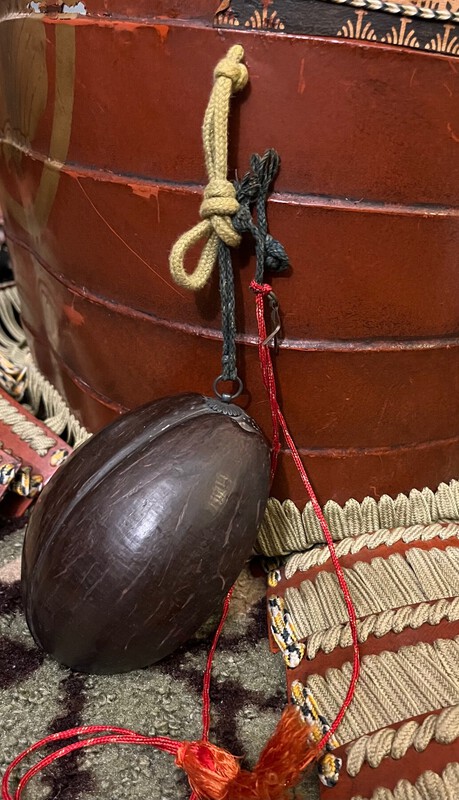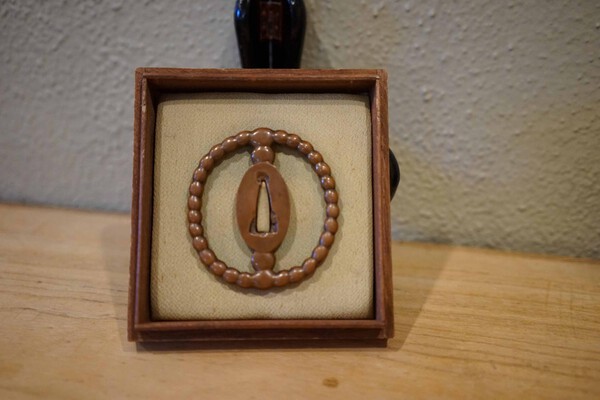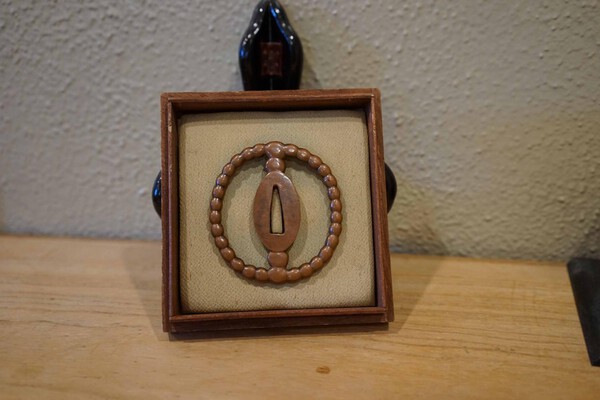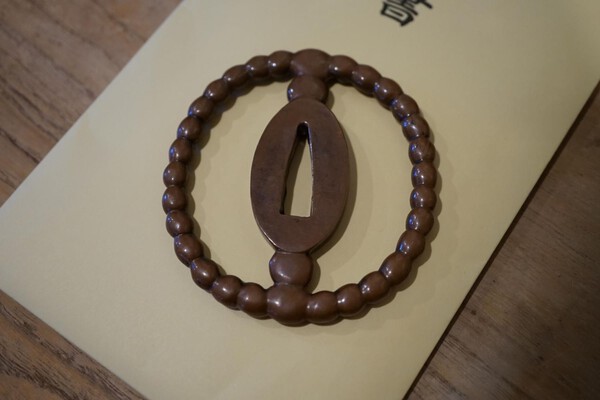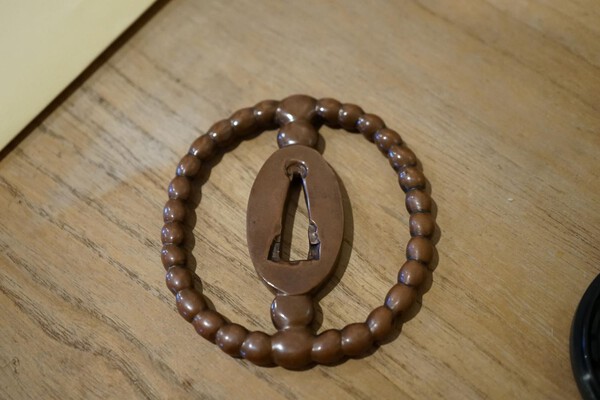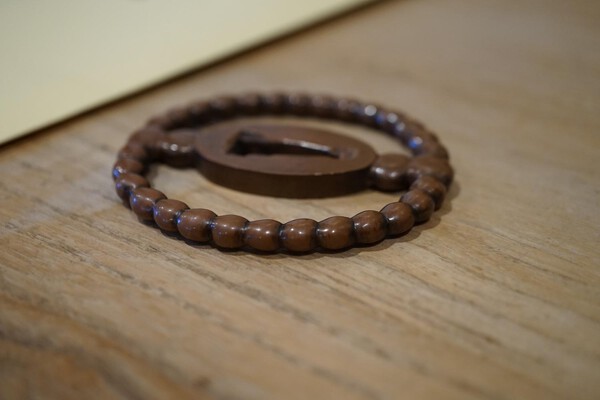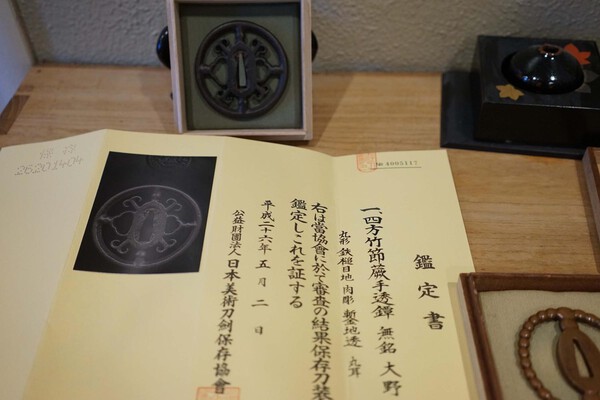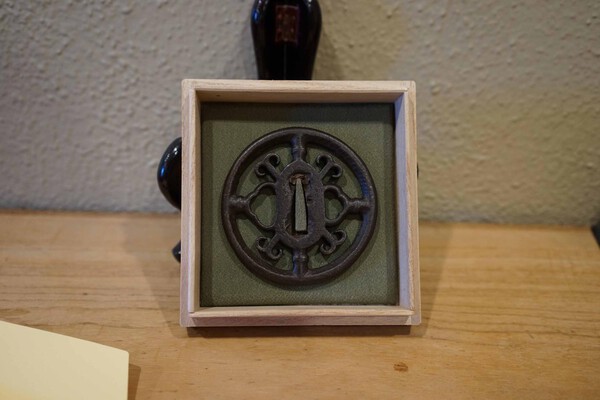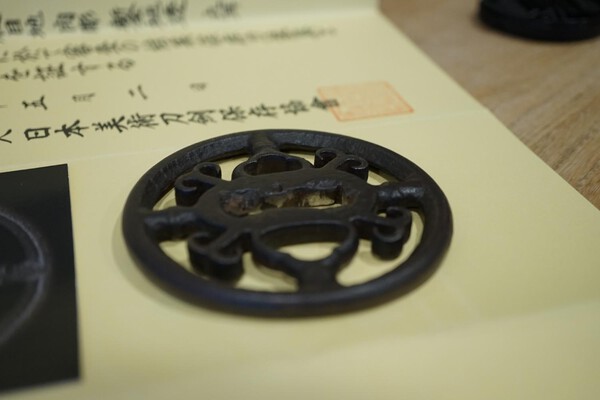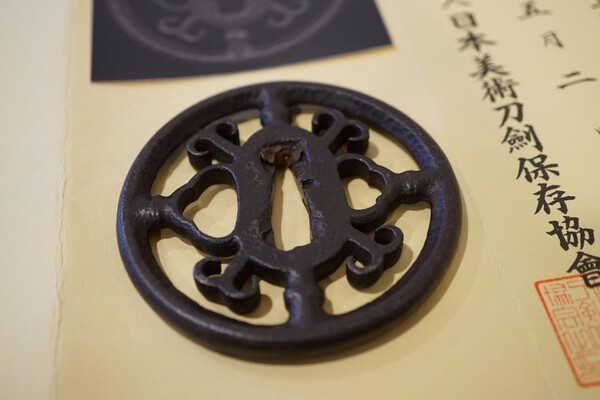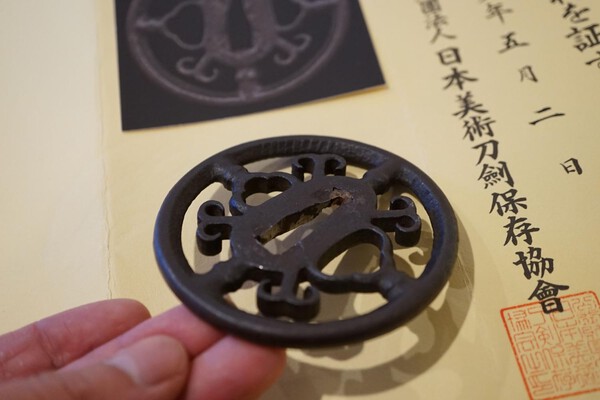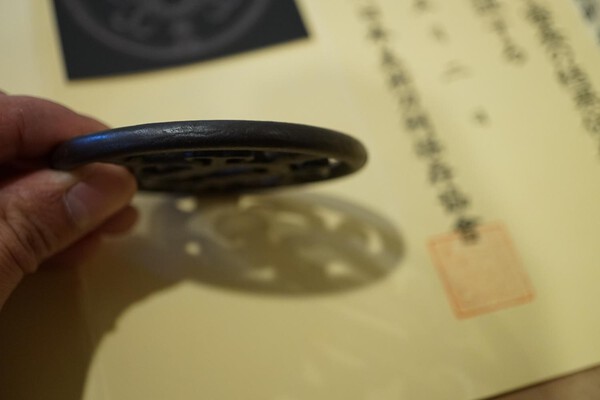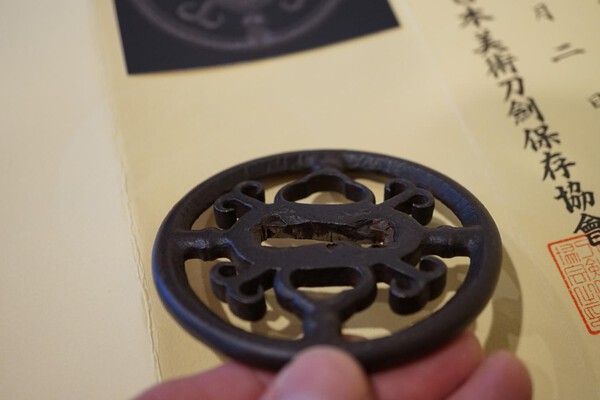-
Posts
732 -
Joined
-
Last visited
-
Days Won
1
Content Type
Profiles
Forums
Events
Store
Downloads
Gallery
Everything posted by kaigunair
-
thanks. the dou is a reproduction. I believe there may have been a matching half that is missing. The red rope may have tied them together. I guess the two could have been used for drinking cups. but was thinking there was a name for these things other than an unusual inro type thing.
-
Curious to know what this item would be called that hangs from the rear right side of a dou (modern reproduction, but must be something fairly common to be included). This one appears to be missing a half, so curious what would normally be carried in here. Thanks in advance.
-

Fun auction to support the forum. Proposal.
kaigunair replied to Bugyotsuji's topic in For Sale or Trade
$400 -
In the same vein as hidden Christians, there were a number of domains that were anti-tokugawa during the entire edo period. If any warrior wares would express hidden messages, these daimyo's and samurai's wares would have. its interesting that little to no research is done on studying tsuba symbolism from these domains for anti-tokogawa themes. For all the same reasons that have been raised about the dangers of being against the dominant authority (the shogun and note the emperor), any such themes would have to be at the level of any hidden Christian tosogu, and even more hidden than the overt/obvious machibori expressions of shogunal dissatisfaction and the social class that originally was intended for.
-
count me in for pdf and hard copy.
-
These tsuba are for sale, with prices listed and background given. I am surprised at the editing. I had thought that 2 years would be sufficient time for things to get properly resolved, but recent forum posts made me realize that was a false hope. And it looks like being patient and considerate is not looked kindly upon when discussion a problem with an "esteemed" member...was never final and done on this side. These two tsubas are for sale, lovely though they may be, because they leave an extremely bad bad taste in my mouth every time I go though my collection. So I want to pass them on to someone who will enjoy them for the pieces they are and not the negative experience I associate with them. It also helps to explain the greatly reduced prices. The alternative would be to cut them up and scatter them to the wind. I hope to find the former. I hold that character is connect to a man's word, so here is my guarantee for the purchaser of either of these tsuba: I guarantee 100%, forever, that these items are what I say they are. Buyer has 7 days from date of deliver to return for any reason for a 100% refund of purchase price minus the cost of shipping but the item must be returned in its original condition as was shipped out (in the case of tsuba, no cleaning or polishing or messing with it). If, however, something is not as I state it is, then the refund is 100% including full refund of any shipping costs. Since I was not around when these items were made, in addition to the 7 day inspection, if at anytime in the future an item turns out to be something else beyond a reasonable doubt, say modern if I represented edo, then the 100% refund plus refund of shipping applies if the item is returned in the exact same condition as I shipped it to you. This is guarantee that I also list in some for on the very rare times I ever list anything on ebay. Doesn't necessary apply for these two since one is papered and one is modern, but if I make a promise of papers for an nihonto/tosogu item that has none, that promise will lasts for 2 years after date of shipment and you will have to go through one of 3 dealers I personally approve of and know to be honest men, to have them papered in the condition I shipped it out to you (nihonto.com, tetsugendo.com, yakiba.com, perhaps a few others I trust) - a 3rd party to keep all parties honest and happy when the results come in. I will not submit it, and you cannot submit it yourself. If it comes back without papers when I said it would paper, I will also pay $100 towards your shinsa costs upon return of the tsuba in the same condition as shipped if no papers were issued. I will pay 50% of the shinsa costs if the papers were issued differing from any explicit guarantee I make regarding what it will paper to, and the papers are included in the return. If you keep the paper or don't want to return the item, then that is a different situation altogether. Also this is the reason and need for the 3rd party shinsa submission. Hamfish - you sure it was me you bought your photos from? Maybe I've sold a few jpn pilot photos in the 16+ years I've been mainly buying on ebay. But my user name isn't kaigunair or kaigun-anything on ebay. But if it was me, let me know if you have a complaint about any photos you bought - as I've made the same form of this guarantee as far back as 2005 if not earlier. And BTW, you'd be the first as I've never had a complaint or anything I sold returned....but I've also mainly be a purchaser not a seller (I also have a bad habit of over packing and eating shipping costs). Hamfish, if you've mistaken me for someone else, then perhaps an edit and apology would be appropriate.
-
Tsuba #2: This tsuba was represented as a Haguro or buddist prayer bead. It was guaranteed to paper "Hozon". Like the first, it was submitted immediately to shina through the seller...and returned without papers. he insists that the shinsa team got it wrong, that there is age in the form of soot on the tsuba from many years of exposure to candle dust filled air. I purchased this for $1500 but since it did not paper, it is most likely a modern made tsuba. Price: $500
-
These are two tsuba I purchased directly from a seller back in 2014. I purchased them with certain guarantees and promises that they would paper a certain way, and had him send them in for NBTHK papering directly. Tsuba #1: Ono School tsuba including NBTHK papers. I purchased this looking for a solid ko-akasaka study piece and example. He promised that this one would paper ko-akasaka, with a side bet that it would paper to the 2nd or 3rd akasaka master. Papers came back Ono school, but he insists the shinsa team was incorrect and that it should be an early akasaka master. I paid $1200 plus cost of shinsa papers. Price: $1000
-
I'd actually refine that comment to members who have been around for a long long time in the larger sword collecting community not just on this forum; collectors and sellers who are known and have established themselves and their reputation in the larger sword collecting community and not just online. Just because a person gives out lots of free advice, doesn't mean he won't take advantage of new collectors given the chance. Buy books first! Lots of good lists of which ones to chose from. The good books show you the best pieces - then you can compare what you're finding online to the good stuff and decide if you like it yourself, and formulate better questions regarding what you're seeing.
-
and yet, there is something called a "railroad watch" because of its origins and use, it following a sort of standard set by its typical user.... but perhaps this type of tsuka held a jitte vs some sort of modified bokuto, or maybe a teppo. most bokuto examples seem to be only koshirae.
-
Congrats! Lovely piece and looks like it was worth the wait. good talking to you at the show too.
-
Love that movie, one of the best samurai flicks out there... "The farmers have won. We have lost." - Shimada
-
Looks like I've hit a nerve. By equating the bushi class to the nazi regime is what one would consider an extremist view of history. That you use vitriolic, condescending, and ill-mannered language to do it speaks volumes of what your idea of a gentleman is. It is a lesson on how dissenting views can be dismissed through intimidation and ridicule - the nazi and fundamentalists alike would be proud. Getting past your emotional responses, I see why you would hold such a view: you have repeatedly chose to put the chonin culture on some sort of pedestal. I can see if you're angling to connect your work to the lineage of these Edo period artists. Since you like to goggle definitions, look up chonindo and try to provide a historically accurate and bias free report on its origins and connections to the bushi class. Its nice to see that we both feel we're speaking to a brick wall. No historical support? What about the historical examples of the tozama samurai and their involvement in the overthrow of the tokogawa shogunate. This was provided to counter your opinion that all warriors could be lumped together with the Shogun, and therefore all were an uptight bunch. What an insult to all those tozama domains. Subversion for centuries is clearly evident in tozama samurai; any disagreement is not based on historical fact and is an uninformed opinion. What about kikusui themed fittings? Interesting how you conveniently left any comment on that out. That you disagree with the other examples (Monkey and gourd is not the same as catfish and gourd when it comes to subversive themes) doesn't mean these aren't subversive, but only you don't see them as such because of your interpretation of them, which is part of the problem for subversive themed tosogu - IT ISN'T OBVIOUS, DUH! What about the parallel idea of judging the number of Christians in Japan based on "acknowledged" Christian themes? Because this analysis fails, it implies there is some sort of problem with the current understanding of tosogu themes. A hypothesis as to what is wrong and how to correct it would be appropriate, but when you're dismissing any evidence that doesn't already lead to the established dogma, its impossible to meet your standard of limited evidence. You seem to like to make sweeping generalizations, remaining silent on inconvenient truths, then stating that no support has been offered for an idea that runs counter to yours. Working with youth for many a summer, I am familiar with this method of "debate". Your ideas about the bushi and Iki are completely unsupported when you look at the outlandish costumes (and I would include tsuba themes) of the momoyama era. They also run counter to the kabukimono (again bushi) which pre-dated the kabuki culture that I'm sure you'd have a lot to say about. These points being that both chonindo and kabuki had a very much love / hate with the bushi, not the hate/ hate view you would like to re-interprate into history. I have yet to read any body of literature that purports the idea that machibori tosogu artists of the Edo period were drivers of culture. Theater actors, screen and woodblock artists, tea practitioners, yes. machibori artists, no. The art in machibori tosogu is normally derivative, taken from some famous scroll or print or story, often times a xerox cropped and scaled to kozuka format. We do have records of real artists dabbling in tosogu, but this was usually a secondary hobby and not where they "made their bones". And according to the chonindo, neither creativity nor originality nor rebellion was a central tenant, but catering to the customer was if they were to get paid. So it would be more correct to assume any piece of tosogu was a made-to-spec'd order by a craftsman hired to carry it out vs the western idea of an artist creating pieces only when inspiration hits, and hung in a gallery waiting for just the right buyer (there are always exceptions). It was firstly a means to put gohan on the table for both Iebori and Machibori alike and the best way to do that was to please the consumers. Therefore, implying or stating that machibori tosogu artists are the source and bastion of subversive themes in tosogu is not a logical conclusion. The source of the themes would have been the customers, and for subversive themes, we should look to tosogu made for customers who would have held the most subversive thoughts and motives against the tokugawa - the tozama bushi. It is this last point where I see we can have a gentlemanly disagreement...or not.
-
Brian, I'm good with this level of "confrontational". Anything interesting should illicit strong emotions, but it is nice to attempt to keep the ideas and topic focused to the main arguments vs the person offering the counter opinion. I am offering up an untested idea, so I can appreciate some of Ford's head slapping and frustration while trying to ed-u-macate another hobbyest bumpkin with a another cockamamie idea... Hopefully you're ok with this level too, but this is your sandbox (and thanks for trying to keep out the poop)....
-
Ford, Actually this started off because I was pointing out your one dimensional characterization of the bushi class. What you see as illogical is based upon your assumption that I am offering up a researched theory, when what I have been offering is a testable (i.e. not tested) hypothesis. And yes, all hypothesis are based on underlying assumptions and presuppositions, which I can see you clearly don't agree with. And a hypothesis is formed usually because something does not conform to the accepted dogma of the day. Why make an ad hominem attack when you don't agree? Arse this and arse that - Just say you think I have my head up my ass with my ideas. Be more bushi about it. Or how about a machibori approach: As to defending my hypothesis, some areas of study towards suggestions regarding subversive themes: Kikusui themed items. Monkey and gourd themed tosogu. Satsuma fittings on "Fuji", where the mountain cap is rendered with 3 separate peaks. Meaning behind Choshu landscape themes. goto mod 1.isimage.zip
-
Ford, You misunderstand me. I do not believe that all samurai were all "deep, meaningful and stoically (sp)". Rather, its that I don't believe they were all inhuman brutally oppressive mini-dictators who merely upheld tenants of bushido when convenient, who did not care at all about farmers or merchants, seeing them only as fodder and animals to be exploited at every chance. And that all these wanna be warriors were completely subservient to the Tokugawa Shogunate after the dust on Sekigahara settled. Quote Did they?....can't say I've noticed it much in tosogu. - Agree. But not noticing and not existing are two different things. If anything, I'm hoping discussions like this spur on our search and understanding, knowing we should be seeing more examples. Here is an analogues situation: We know for historical fact that there were a great number of Kiristian among the daimyos and samurai in the 16th and 17th centuries. Yet if we based our figures on the number of corresponding number of verified "Christian" themed tsuba, we'd come up with a different figure. Are we saying that this is because they didn't exist or were only nominal followers for which Christianity would not have be reflected on their tosogu, or does it have something to do with our understanding of what constitute a "Christian" tsuba. What would be acceptable "proof" in the context? Regarding machibori themes, I am not saying their themes were not deep, but that they were obvious. Like a guy fawkes mask or lady gaga. Again, perhaps studying how dissent is outwardly signaled in communist China would be better than trying to put a western spin on what we think it should look like. What I don't think Edo period Japan could be compared to is North Korea. I had wanted to get through all the references you had initially posted, as I try to do on all posts. But you posted to entire books without explaining their relevance (perhaps for me to infer from titles that they support your viewpoint?). It is a good reading list nonetheless and I will pick up titles as time and opportunity present themselves. I admit I cannot link my ideas to published works and academic papers and the burden of proof of my counter-viewpoints to your comments are on me. I've attempted to add my reasoning and explanations to the extent appropriate for an online forum vs an academic paper.
-
Ford, While I understand and have believed much about the samurai vs merchants and farmers, it is interesting to ponder how much of the current view point is based on the meiji narrative of the Edo period, as well as post wwii anti-militarism spirit. I love a kurosawa as much as the next guy, but he had a POV and narrative to tell which we can debate about how historically accurate it was. How much of this would be like future studies on life during the early 21st century, looking at the Occupy, Fruitvale and Ferguson protests and extrapolating what life was like in the early 21st century. What level of control of the arts and daily life would be attributed to the 1%'ers? How political is all the artwork (including movies and television) during this time and how much of it fluf to make a buck? Its interesting to look at current Chinese cinema and their view point of pre-communist life of the everyday man. How different or similar is basis for which we form our view of the bushi class during the Edo (early, mid, late) or other periods? But more on topic, for comparison purposes, Iebori themes would be better compared against something like Kaga goto, the Maeda being a tozama daimyo. Or against the themes of Satsuma and HIgo works. We might wonder whether there were hidden meaning behind the oft neglected Choshu landscapes. These were daimyo who felt they had a better claim to the throne than the Tokugawa, better background and pedigree, learning and nobility. As warriors, they would not have taken Tokugawa rule on their backs, and would have taken every small opportunity to communicate their disdain - so why isn't this in our tosogu studies? The typical machibori examples, while taking technical skill and perfection to new heights, would not have been initially crafted to contain the same depth of symbolic and often times subversive meaning compared to fittings produced in domains whose clans chafed under Tokugawa rule. Machibori were produced to appeal to the general public, and would more readily reflect a hopeless resignation of those not in power - the ephemeral nature of life, with the best example being ukiyo, and the "floating world" of the pleasure quarters. As you pointed out, when the bushi class lost control of the wealth, corresponding power shifted to the nouveau riche merchant class - the feeling of the machibori could be more akin to "bling bling, or flash for those frequenting the red light district. Yes, culture and learning dictated that machibori themes would also evolve to touch upon tea, and the themes would get more deeper as machibori became more acceptable to the bushi class. But if we're looking for subversive themes, my money is on early Edo regional fitting themes. On a personal note, my own family background demonstrates that going back just 2 or 3 generations, bushi class status was still an important aspect in everyday Japan. If there was any enmity or disdain from the "lower classes" who were oppressed by the big bad samurai, it ended when you had the chance to become part of the bushi class. This would be the time corresponding to the late meji and into the pre-war showa period. Would love to discuss over drinks one day. Somewhat related is the fact that its only been a few years since Google got into some trouble after it posted Edo period maps against current modern maps- buraku district were being shown and families attached to those areas were upset this information was becoming public.
-
Ooh, have to disagree. Tozama vs Fudai samurai. Higo exile of Sansei was one, Satsuma and Choshu samurai were quite oppressed and resistant to the Tokugawa shogun and his boys....up to the point of the Meiji restoration. To imply that these warriors were anything but in opposition to the establishment, for hundreds of years, would be re-writing history. Its surprising that the study of tosogu DOESN'T include a deep analysis of the subversive and anti-shogunate message fittings produced during the Edo period probably contain depending on what area and what clan ordered them... (probably doesn't apply to machibori kinko to the same extent) My understanding of Edo period classes is that the "merchant" class still wanted to be bushi class...and paid to be adopted into it when they could. If anything, I would think the practice of samurai wanting to be part of the nobility was in decline after Oda/Hideyoshi/Tokugawa. But I would love to see some historical evidence that the merchant classes stop seeing themselves as less than the bushi class...
-
what's on the koiguchi? If not another wasp, I'd guess a butterfly, cricket, katydid and mantis, in that order. I've read that when tosogu depict insects, the variety of insets can represent the various classes of society. Ground work is interesting, and the insects seem more detailed that typical mino work. Definitely a nicer than average set. Can you share the tsuba that's attached to this quaint koshirae?
-
if you adhere to the schools as currently defined & papered, I would say fact or, more accurately, theory/law as understood when testing a hypothesis. but the study of these things definitely aren't (yet) even remotely close to scientific... please enlighten if you know otherwise! also, the dogma of the saotome is that it was a katchushi (or branch of) from the famous armor makers. this paper could be pointing out that terms could also be seen as interchangeable, like someone is saying that what we think of as saotome wasn't or can't be necessary always attributed to the saotome school. Makes sense if we think that, like much of machibori, without a signature, someone skilled could make this tsuba, even if the design might have at time point in time been attributed to the saotome.... I had always thought of the design as a kiku chrysanthemum. from this past meeting, it was shared that the design was modeled after the opening on the top of the kabuto (teihei?), one of the 3 things I learned at this past meeting (inside joke).
-
Perhaps a possible distinction they are making in the papers has to do with the fact that its normally ok if some/many of the spokes are brazed/soldered in Saotome vs the large size and all carved spokes of this particular example, so "Katchushi" to set it apart from the normal Saotome examples. If you have two identical examples of these side by size, and one has brazed in spokes and the other doesn't, it would make sense to try to differentiate between the two (hozon vs tokubetsu hozon, saotome vs ?) Almost would be two completely different techniques and skills, even if the result is the same.
-

San Francisco Token Kai
kaigunair replied to Pete Klein's topic in Sword Shows, Events, Community News and Legislation Issues
Friday $15.00 (8am - 12pm dealer set up only; 12pm-10pm general public) Saturday $ 10.00 (9am 12pm) Sunday $ 10.00 (9am to 4pm) Weekend Special Rate $ 25.00 (Fri-Sat general public hours) The show is oversold with tables, and I have it on good authority that there will be new dealers from Japan (one emailed me saying they would be there). The kantei light set up will again be available for free use, but due to the number of tables sold and lack of space, it will no longer be under the large tent in the corner. There will also be a NBTHK exhibit (free for members, open to general public for a fee - Correction: I've been told the general public viewing is on Friday, but don't quote me). No shinsa this year. Largest nihonto collector show outside of Japan. Happy hunting! -
You probably touched on something important regarding the mis-match of themes. They were probably made by the same hand, but if we imagined these as sukashi themes, noticing the similarity of construction would more likely indicate same "school" vs a formal dai-sho set.
-
I only ask because the pics make the body of the kogai look like iron- pics are really dark and can't make out much surface detail - could be my monitor. My initial through was that the "inlay" was red rust on iron, but again, might be the pics just aren't showing up correctly for me. If any doubts, do a quick magnet test. If yamagane, does seem to fit the ko-kinko style. but I'll let the experts chime in....
-
Yup, its a kogai. Q: Is this yamagane, shakudo or iron?


